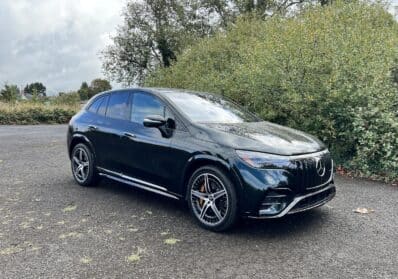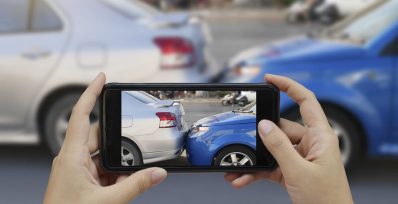Hyundai delivered an unexpected surprise when it rolled out the Santa Cruz concept vehicle at the Detroit Auto Show back in January 2015. But, at the time, there seemed little chance the South Korean carmaker would actually bring the compact pickup to market.

The fate of the Santa Cruz continued to remain shaky, even after Hyundai announced plans to put it into production later that year. There were the obvious technical challenges, but the bigger issue was finding the right target audience for the quirky design, with its relatively tiny cargo bed and a unibody platform, rather than the body-on-frame design most truck buyers look for.
What has been dubbed a “Sport Adventure Vehicle” is finally ready for production and TheDetroitBureau.com headed out to — where else — Santa Cruz, California for the chance put the 2022 Hyundai Santa Cruz through its paces and see if there really is a potential market.
Overview
The Hyundai Santa Cruz is only the second pickup on today’s market using a crossover platform — one it shares with the familiar Hyundai Tucson SUV. Santa Cruz is clearly not your typical truck, but that’s what could make it a hit with the type of buyers who might never have imagined owning a pickup until now.
Hyundai is betting it can rekindle the one-time love-affair that young Americans once had with compact trucks — a mainstay staple when Baby Boomers were first getting their driver licenses. But the bet is risky, at least if you consider more recent failures, such as the Subaru Baja.

At 195.7 inches, nose-to-tail, Santa Cruz is about 10 inches smaller than today’s midsize pickups — like the Honda Ridgeline, the only other crossover-based model now on the U.S. market. And that, Hyundai is betting, is just fine with the sort of customers it’s targeting, with a heavy emphasis on urban dwellers who want something small enough to maneuver around the city during the week, yet versatile enough to take on adventures on the weekend.
It’s also quite well-equipped for the money, with plenty of tech and digital safety features, as well as some well-executed design details, such as the locking under-bed storage compartment.
To get a measure of the new truck, I spent a long day of driving all over Silicon Valley, across to the picturesque coast and then back along winding roads through old growth redwood forests. If my initial impression holds, Hyundai should find a ready market for the 2022 Santa Cruz.
Exterior
Hyundai chose not to play it safe with Santa Cruz. They could’ve followed the lead of Honda, which has continued to make the Ridgeline more traditionally truck-like with each successive iteration. Instead, designers at the automaker’s California styling studio decided to double down on the edgy look of the original concept.

“It is a vehicle that completely shatters conventional design,” Jose Munoz, Hyundai Motor America CEO, proclaimed when the production model debuted last April.
Up front, Santa Cruz picks up on Tucson’s bold, upright face and three-dimensional “parametric” grille, with pod-like assemblies framing the truck’s lamps. But the fast windshield and other design cues give it almost a sports car feel, and a sense of being in motion, even when parked. The back end is all about business, however.
Those who might remember the original Santa Cruz show car might be in for a bit of disappointment when they learn that the sliding bed extender concept didn’t make it into production. It was too heavy, too costly and too technically complicated to pull off, especially considering the pickup’s price point. But Hyundai designers have found some creative ways to make up for that loss.
Though shorter than midsize pickups, Santa Cruz is nearly as wide, something emphasized by the tailgate’s distinctive T-shaped taillights. The tailgate can fold down partway, making it easier to carry lengthy cargo, whether lumber or surfboards and other adventure gear. The 4-foot wide bed itself features numerous tie-downs and attachment points, as well as places where you can lay down 2×6 boards to create a flat surface for carrying things like sheets of plywood. There’s also a cage-like bed extender for when the tailgate is completely opened.

Add that locking under-bed storage compartment which can hold a couple weekender bags, muddy hiking shoes, even buckets of ice to serve as a cooler for tailgating. The unit can be washed out and emptied, thanks to a drain plug. Hyundai has come up with dozens of options, including a metal tonneau cover that opens like roller blinds.
And to help keep track of their wanderings. Hyundai has provided owners with special attachment points built into the cladding above the pickup’s 20-inch wheels to mount GoPro and other video cameras.
Interior
By stretching the Tucson platform Hyundai has given the Santa Cruz a reasonably roomy interior easily fitting four and, if needed, five. The two models have a number of things in common, including plenty of storage. The Santa Cruz adds usable space under the fold-up rear bench. You even can remove the back bench, if necessary.
Like Tucson, the new pickup gets a base, 8-inch touchscreen with an optional, 10.25-inch upgrade. There’s a similarly sized digital gauge cluster that appears to float off the instrument panel, as if you’d positioned a large iPad behind the steering wheel.

As with other recent Hyundai entries, the automaker has given the Santa Cruz a much more refined cabin than many might expect at this price point, with plenty of soft-touch and well-balanced details. If I had one complaint it was the lack of a volume knob, Santa Cruz requiring you to either slide your finger on the touchscreen or turn to the toggle on the steering wheel. There are plenty of capacitive touch “switches,” however, making it easy to adjust climate settings and switch between functions on the infotainment screen.
There are a few other things that would be nice to have, starting with a fold-down mid-gate that could extend the bed into the back seat. Meanwhile, while the rear window does slide, it must be operated manually, making it out of reach if there’s no one in the back.
Powertrain
The 2022 Hyundai Santa Cruz offers a choice of two powertrains, both of which are paired with an 8-speed automatic.
That starts with a naturally aspirated 2.5-liter inline-4 that turns out 190 horsepower and 180 pound-feet of torque. I didn’t have a chance to drive the base, or Standard, model while in California but hope to report back in the near future.
My tester was a Santa Cruz Sport featuring a turbocharged version of the 2.5-liter I-4 bumping power up to 275 hp and 310 lb-ft. One nice touch was the addition of paddle-shifters which worked well with the fast-shifting engine.

The Hyundai pickup — er, Sport Adventure Vehicle — will hold up to 1,700 pounds. Max, that is, with that dropping to just 600 pounds if you’ve got passengers in every seat. The naturally aspirated package can tow an acceptable 3,500 pounds. The turbo bumps that up to 5,000 pounds, a full 250% more than the Tucson.
Hyundai’s HTRAC all-wheel-drive system is available with the base engine and standard with the turbo. As with the pickup’s suspension, it’s been retuned from the Tucson to handle more rugged driving situations. Three modes are available, to cope with different driving conditions.
One surprise comes with fuel economy. The base engine delivers 21 mpg city, 27 highway and 23 combined — in all-wheel-drive configuration. Oddly, it loses 1 mpg highway with the front-drive layout. The turbo, sold only with the H-TRAC package, gets 19/27/22 mpg.
Safety and Technology
The 2022 Hyundai Santa Cruz starts out with a reasonable package of tech features, including Apple CarPlay and Android Auto — wireless on higher trim levels, as is, wireless smartphone charging. And I found myself really appreciating the optional Bose premium audio system.
One nice, though not especially high-tech, feature is the optional 120-volt outlet in the bed, along with three separate LED bed lamps.

The standard Hyundai SmartSense safety system includes features like Forward Collision Warning with brake intervention and pedestrian and bicycle detection, as well as Lane Keeping Assist. A number of systems, including Highway Driving Assist, Blind Spot Monitor and Rear Cross-Traffic Collision Avoidance, are optional.
Driving Impressions
Here’s where the 2022 Santa Cruz really shines. I spent plenty of time scooting along winding mountain roads and found my confidence growing by the mile. Compared to traditional, body-on-frame pickups, the word, “nimble,” is completely appropriate.
The Santa Cruz offers a good feel of the road, a composed suspension and little body roll. Front and rear disc brakes do a good job of quickly and quietly scrubbing off speed. For those who’d like the functionality of a pickup but with more sporty drive manners, the new Hyundai is really going to connect.
Around town, the truck is much more quiet than most midsize pickups I have driven of late, Hyundai putting a premium on wind, road and engine noise dampening.
In terms of functionality, you do sacrifice a bit compared to midsize models, such as the Ridgeline, Ford Ranger or Toyota Tacoma. But the creative steps Hyundai has taken with the bed design should minimize the impact for most buyers.

On the downside, the fuel economy isn’t quite as good as I had expected. Ridgeline, for example, gets up to 24 mpg combined. And the new hybrid version of the Ford Ranger launching next year will deliver an estimated 40 mpg in both the city and combined columns.
Wrap Up
It’s hard to believe it’s been more than six years since the Hyundai Santa Cruz made its debut in concept form. Yet, there’s still plenty of buzz as it finally rolls out in production trim. And for good reason. The 2022 pickup is attractive and versatile, striking a good balance between functionality and sportiness. It’s fun to drive, whether around town, on the highway, or out in the back woods.
Yes, there are compromises when it comes to the cargo bed, and we’d have liked to see better fuel economy numbers. But those aren’t deal-breakers by any means.
It’s been years since Americans had anything to choose from in the compact pickup segment, so it will be intriguing to see what happens now – all the more so with both Ford and Hyundai set to face off. The Detroit truck will be targeting a more traditional buyer than its Korean rival. And each will have distinct advantages.
I’m betting that Hyundai will find a ready market for the 2022 Santa Cruz among urban buyers who’ll want a nimble, stylish set of wheels for day-to-day chores, that will be ready to go for their weekend adventures.
2022 Hyundai Santa Cruz — Frequently Asked Questions
Is the 2022 Hyundai Santa Cruz available with 4×4?
The Hyundai H-TRAC all-wheel-drive system is optional with the base, 3.5-liter engine but comes standard with the upgraded 3.5-liter turbo engine.
How much is the 2022 Hyundai Santa Cruz going to cost?
The base version of the Santa Cruz pickup starts at $23,990 – plus delivery fees, taxes and other fees. A fully loaded version, including the optional turbo engine, Bose audio and the full SmartSense safety suite tops out around $37,520.
How fast is the Santa Cruz?
Hyundai hasn’t provided factory numbers but the turbo engine should launch it from 0-60 in under 8 seconds.











